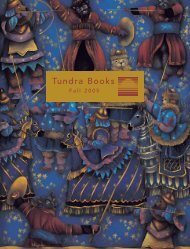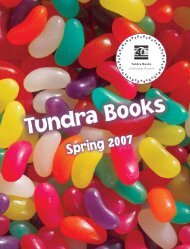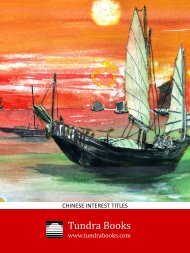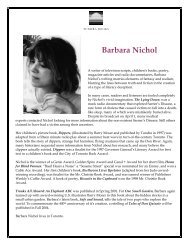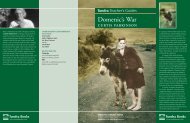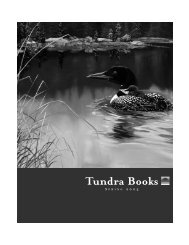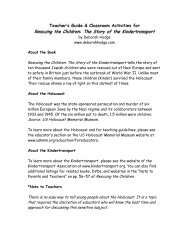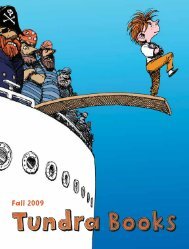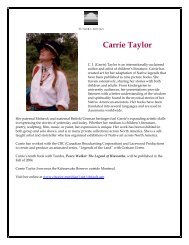World Vision Early Readers - Tundra Books
World Vision Early Readers - Tundra Books
World Vision Early Readers - Tundra Books
Create successful ePaper yourself
Turn your PDF publications into a flip-book with our unique Google optimized e-Paper software.
<strong>World</strong> <strong>Vision</strong> <strong>Early</strong> <strong>Readers</strong><br />
Guided reading activities for primary and junior grades supporting Language Arts, Literacy,<br />
Social Studies and Arts learning outcomes.<br />
Written by Katharine Kan and Hoa Truong-White. Edited by Nancy Del Col<br />
This printed resource may be reproduced for not-for-profit educational use provided the source is properly acknowledged.<br />
Produced by: <strong>World</strong> <strong>Vision</strong> Canada, Education and Public Engagement, 2009
Mom and Me Grades K-3<br />
Mom and Me<br />
Guided Reading<br />
Activities<br />
Language Arts, Literacy,<br />
Social Studies and Arts<br />
Preparation<br />
• Copy a class set of “Mom and Me Photos” (page 3)<br />
• Copy a class set of “Mom and Me Speaking and Thought Bubbles”<br />
template (page 4)<br />
• Obtain copy of Mom and Me by Marla Stewart Konrad (<strong>Tundra</strong><br />
<strong>Books</strong>, 2009).<br />
• Have a world map or globe ready for identifying countries represented<br />
in the photos.<br />
• For the Grade 4 to 6 art activity, gather found and recycled materials<br />
such as fabric, buttons, cardboard, Styrofoam, etc.<br />
Instructions<br />
Before Reading: Activating Prior Knowledge<br />
Write the following suggested statements about family members on<br />
the board and ask students to complete the sentence starters orally:<br />
My mom is proud of me when ______________________________<br />
My dad comforts me by ____________________________________<br />
My sister or brother helps me _______________________________<br />
I know my grandparents love me because _____________________<br />
Students will<br />
• Identify shared feelings with children and<br />
families from other countries<br />
• Identify cultural similarities and differences<br />
between families in communities around the<br />
world and their own community<br />
• Develop oral, visual and written literacy skills<br />
• Generate and express ideas by responding to<br />
and reflecting on photographic images<br />
• Make text-to-self, text-to-text and text-toworld<br />
connections<br />
Related International Dates<br />
National Child Day (November 20)<br />
International Women’s Day (March 8)<br />
<strong>World</strong> Storytelling Day (March 19)<br />
Mother’s Day (May)<br />
UN International Day of Families (May 15)<br />
Canadian Multiculturalism Day (June 27)<br />
Hide the title of the book Mom and Me and take a picture walk<br />
from cover to cover. Ask students what the book is about and what<br />
they think the title might be.<br />
Ask students: Who takes care of you? What do they do for you? Do<br />
you take care of anyone or anything?<br />
Mom and Me<br />
Build vocabulary and clarify the concepts of proud, comfort, help,<br />
share and love. Ask students to show with facial expressions or<br />
mimed actions what each of the above looks like, or what a person<br />
can do to show it.<br />
Read the book out loud to students, using the questions below to<br />
prompt discussion about the photos. See list of photo credits in “Appendix<br />
A: Mom and Me Photo Credits”(page 8).<br />
1. Describe what is happening in this photo.<br />
2. How are the people in this photo feeling? How do you know?<br />
3. What do you think happened before this photo was taken?<br />
4. What might have happened after this photo was taken?<br />
5. How does this photo make you feel? Does it remind you of<br />
anything?<br />
6. Did you see anything in the photos that surprised you? That<br />
you would like to know more about?<br />
7. Whose voice is telling the story of Mom and Me?<br />
<strong>World</strong> <strong>Vision</strong> <strong>Early</strong> <strong>Readers</strong><br />
2
Mom and Me Grades K-3<br />
After Reading: Inferencing<br />
Ask students to choose two or three of their favourite photos and<br />
invite them to discuss what they know about the cultures depicted.<br />
What clues in the picture help reveal where these children live (e.g.<br />
clothing, appearance, environment)?<br />
Speaking and Thought Bubbles<br />
Distribute the class sets of “Mom and Me Photos” and “Speaking<br />
and Thought Bubbles”, one per student.<br />
1. Ask students: Do we always say what we think? Discuss times<br />
when we need to speak and times when we need to think.<br />
2. Explore dialogue and perspective by asking students to fill in a<br />
thought or speaking bubble for each person (or animal) in the<br />
two photographs. Cut the bubbles out and paste them onto the<br />
photo. What are they thinking and what are they saying?<br />
3. Working in partners, ask students to imagine that the people in<br />
the photo from Cambodia want to speak to the people in the<br />
photo from Sudan. What would they like to know? Write a series<br />
of speaking bubbles for what they would say to each other. Organize<br />
the speaking bubbles by numbering them and pasting them<br />
in order on the photos.<br />
4. Ask partners to play roles and share their dialogues with the<br />
class. Display the finished dialogues on the wall to be read by<br />
other students.<br />
Suggested Mom and Me Art Activity:<br />
Grades 4 to 6<br />
Get students to research mother and child figures depicted in artwork<br />
on the Internet or in books (see link below). Look for similarities between<br />
great works of art and the photos in Mom and Me. Suggest<br />
why mothers with children are a universal subject matter for<br />
artists. Have students create a three-dimensional sculpture of<br />
a mother and child figure using found objects and recycled<br />
materials. They can reproduce a famous work of art, depict<br />
a photo from Mom and Me, or create an original scene.<br />
The following link provides famous examples of mother<br />
and child figures in painting and sculpture from throughout<br />
history and different cultures.<br />
Mother and Child Figures: The Metropolitan<br />
Museum of Art<br />
http://www.metmuseum.org/toah/hi/hi_fimo.htm<br />
<strong>World</strong> <strong>Vision</strong> <strong>Early</strong> <strong>Readers</strong><br />
3
Mom and Me Grades K-3<br />
Reproducible Master<br />
Mom and Me photos<br />
Mother and son, Cambodia (Sopheak Kong, <strong>World</strong> <strong>Vision</strong>)<br />
Mother and daughter, Sudan (Jon Warren, <strong>World</strong> <strong>Vision</strong>)<br />
<strong>World</strong> <strong>Vision</strong> <strong>Early</strong> <strong>Readers</strong><br />
4
Mom and Me Grades K-3<br />
Reproducible Master<br />
Mom and Me speaking and thought bubbles<br />
<strong>World</strong> <strong>Vision</strong> <strong>Early</strong> <strong>Readers</strong><br />
5
Getting There Grades K-3<br />
Getting There<br />
Guided Reading<br />
Activities<br />
Language Arts, Literacy,<br />
Social Studies and Arts<br />
Students will<br />
• identify cultural similarities and differences<br />
between modes of transportation in communities<br />
around the world and their own<br />
community<br />
• Develop oral, visual and written literacy skills<br />
• Generate and express ideas by responding to<br />
and reflecting on photographic images<br />
• Make text-to-self, text-to-text and text-toworld<br />
connections<br />
Related International Dates<br />
International Day for Tolerance (November 16)<br />
International Development Week<br />
(1st week of February)<br />
<strong>World</strong> Storytelling Day (March 19)<br />
Canadian Multiculturalism Day (June 27)<br />
Preparation<br />
• Copy a class set of “Getting There Splitting Image Photos” (page 7)<br />
and cut them apart to create one set of half photos and one set of<br />
full photos.<br />
• Provide pencils, markers or crayons for drawing. Paper and scissors<br />
are needed for older grades activity.<br />
• Obtain copy of Getting There by Marla Stewart Konrad (<strong>Tundra</strong><br />
<strong>Books</strong>, 2009).<br />
• Have a world map or globe ready for identifying countries represented<br />
in the photos.<br />
Instructions<br />
Before Reading: Activating Prior Knowledge<br />
Ask students to brainstorm different modes of transportation. How<br />
do people get from one place to another? How did you get to<br />
school today? Have you ever travelled to another city, province,<br />
country, etc.? If so, how did you get there? What is the most unusual<br />
type of transportation you have used? Record answers on a<br />
T-chart, listing types of transportation on one side and the number<br />
of students who have used them on the other. With older students,<br />
consider representing the findings in a simple bar or pie graph.<br />
Splitting Image<br />
Build vocabulary and clarify the concepts of proud, comfort, help,<br />
share and love. Ask students to show with facial expressions or<br />
mimed actions what each of the above looks like, or what a person<br />
can do to show it.<br />
Read the book out loud to students, using the questions below to<br />
prompt discussion about the photos. See list of photo credits in “Appendix<br />
A: Mom and Me Photo Credits”(page 8).<br />
1. Distribute copies of the “Getting There Splitting Image Photo”<br />
(top half ), one per student. This photo shows a girl from Mongolia<br />
riding a yak. Ask students to suggest what they think is<br />
missing from the bottom half of the photo, but do not reveal the<br />
answer or any background information.<br />
2. Students each choose one idea and complete the photo by drawing<br />
what is missing on the blank part of the paper.<br />
3. When all drawings are completed, have students form groups of<br />
three or four and share their work. Ask them to look for similarities<br />
and differences in their drawings.<br />
4. Distribute copies of the full “Splitting Image Photo” to each<br />
group. Compare the group drawings with the missing piece of<br />
the photo. Did anyone guess correctly? Share some of the creative<br />
ideas developed by the students. Discuss the following: Where<br />
does this girl live? Why is she riding a yak? Where is she going?<br />
What do you think is the same or different about her life and<br />
yours? Would you like to ride a yak? What would it feel like?<br />
5. Create a gallery walk to share the students’ drawings.<br />
<strong>World</strong> <strong>Vision</strong> <strong>Early</strong> <strong>Readers</strong><br />
6
Getting There Grades K-3<br />
Getting There<br />
Read the book out loud to students, using the questions<br />
below to prompt discussion about the photos. See list of<br />
photo credits in “Appendix B: Getting There Photo Credits”<br />
(page 9).<br />
1. Where are the people in this photograph coming from?<br />
Where are they going?<br />
2. What are they doing? How do you know?<br />
3. What is surprising about this photo?<br />
4. Are the people in the photo moving slow or fast? How<br />
can you tell?<br />
5. Close your eyes and imagine the sounds in this photograph.<br />
Make the sounds you might hear.<br />
6. Make the actions that go with this way of “getting there”.<br />
7. Whose voice is telling the story of Getting There?<br />
After Reading: Critical Thinking<br />
Ask students which modes of transportation were new to<br />
them. Add the new types of transportation to the pre-reading<br />
T-chart. Add another column to the chart for brainstorming<br />
other uses for each type of transportation (e.g. a horse can<br />
pull a wagon, a wheelbarrow can carry dirt). Classify different<br />
modes of transportation as human-powered, animalpowered<br />
or machine-powered. Which ones use more than<br />
one type of power?<br />
the three piles to create a five-line found poem. Missing<br />
but necessary words, such as pronouns or prepositions, can<br />
be added and word forms changed to suit the logic of the<br />
poem.<br />
Example: Pedal quickly!<br />
The smiling girl rides.<br />
Laughing friends,<br />
Setting sun,<br />
Big wheels take her home.<br />
Drama Activity: People Movers<br />
Divide class into groups of six to eight. Each group will<br />
construct a fantasy vehicle or machine that can move people<br />
from one place to another, using all members of the group.<br />
The only resource available is their bodies. Groups will<br />
need about 10 to 15 minutes to plan and rehearse their<br />
creations. Finished vehicles are presentedto other members<br />
of the class, complete with actions and sound effects. The<br />
audience tries to guess what the vehicle is and how it works.<br />
Suggested Getting There Art<br />
Activities: Grades 4 to 6<br />
Found Poetry: Words to Go<br />
Create a chart with three columns and headings on the<br />
board. Ask students to copy the chart onto lined paper.<br />
After a first read-through of Getting There, reread the<br />
text out loud, this time without showing the photos. Ask<br />
students to identify all the action words (verbs and verb<br />
phrases). Record them in the first column.<br />
Read through the book again, this time showing<br />
the photographs. Ask students to use descriptive<br />
language (adjectives and nouns) to describe the<br />
people and things in the images (e.g. smiling girl,<br />
sleepy baby, black horse, blue sea, big wheels).<br />
Record these ideas in the second column. Encourage<br />
students to think of as many descriptions as they can.<br />
Brainstorm a list of adverbs inspired by the photos<br />
and list them in the third column.<br />
Using scissors, students cut out the words from each<br />
column, keeping them in separate piles. Instruct them<br />
to manipulate and combine words and phrases from<br />
<strong>World</strong> <strong>Vision</strong> <strong>Early</strong> <strong>Readers</strong><br />
7
Getting There Grades K-3<br />
Reproducible Master<br />
Getting There splitting image photos<br />
Mother and son. Cambodia (Sopheak Kong, <strong>World</strong> <strong>Vision</strong>)<br />
Mother and daughter, Sudan (Jon Warren, <strong>World</strong> <strong>Vision</strong>)<br />
<strong>World</strong> <strong>Vision</strong> <strong>Early</strong> <strong>Readers</strong><br />
8
Grand Grades K-3<br />
Grand Guided<br />
Reading Activities<br />
Language Arts, Literacy,<br />
Social Studies and Arts<br />
Preparation<br />
• Obtain a copy of Grand by Marla Stewart Konrad<br />
(<strong>Tundra</strong> <strong>Books</strong>, 2010).<br />
• Copy a set of Grand photos (Reproducible Master)<br />
• Enlarge a copy of the award ribbon for each student<br />
(Reproducible Master)<br />
• Gather the following materials: world map or globe for indicating<br />
countries mentioned in the book; drawing and coloured paper;<br />
pastels, coloured pencils, crayons or paint for the art activity.<br />
Instructions<br />
Before Reading: Activating Prior Knowledge<br />
Ask students if they know what a senior is. What seniors do they<br />
know in their own families? Explain that a senior family member<br />
is someone much older, like a grandparent, aunt or uncle—someone<br />
we care about and who cares about us.* Different cultures<br />
have different terms for grandparents or older family members<br />
(e.g. nonna and nonno for Italians). Ask students to tell you what<br />
they call their grandparents or other older family members like<br />
aunts and uncles.<br />
Students will<br />
• Identify shared family relationships with other<br />
students and children in other countries<br />
• Identify shared cultural similarities and<br />
differences with families in communities<br />
around the world Generate and express<br />
ideas by responding to and reflecting on<br />
photographic images<br />
• Develop oral, visual and written literacy and<br />
kinesthetic skills<br />
• Generate and express ideas by responding to<br />
and creating visual images<br />
• Make text-to-self, text-to-text and text-toworld<br />
connections<br />
Related International Dates<br />
National Grandparents Day (First Sunday<br />
of September after Labour Day)<br />
<strong>World</strong> Storytelling Day (March 19)<br />
UN International Day of Families (May 15)<br />
Canadian Multiculturalism Day (June 27)<br />
Think-Pair-Share Activity<br />
1. Think: Ask students to think about a senior in their family they<br />
enjoy being with. Ask them to think about things they like to do<br />
with this family member, how this person helps care for them or<br />
how they care for this family member.<br />
2. Pair: Ask students to find a partner and share something they<br />
enjoy doing with their senior family member (e.g. I like to go<br />
fishing with my grandpa.). Ask students to turn to a different<br />
partner and share one way their senior family member helps or<br />
cares for them, or how they help or care for this senior family<br />
member (e.g. My grandma picks me up from school, we bring<br />
meals to my uncle when he is sick).<br />
3. Share: Ask students to share some of their responses from above<br />
with the whole class.<br />
Grand<br />
Show students the cover of Grand. Ask: What do you think this<br />
book might be about? Explain that the book shows children from<br />
around the world spending time with their grandparents or other<br />
senior family members.<br />
Thumb Tool<br />
Show students the photos of children helping or playing with their<br />
grandparents in the garden (use the book or the Reproducible Master).<br />
Ask students to show with a “thumbs up” or a “thumbs down” if the<br />
photo depicts something they’ve done with a grandparent or senior<br />
family member. Read the book out loud to students, continuing to<br />
<strong>World</strong> <strong>Vision</strong> <strong>Early</strong> <strong>Readers</strong><br />
9
Grand Grades K-3<br />
use the “Thumb Tool” to have students respond to selected<br />
photos (i.e. thumbs up if they recognize or have experienced<br />
the situation represented in the photo, thumbs down if not).<br />
Use the following questions to prompt discussion while<br />
reading the book. Use the photo credits at the beginning of<br />
the book to locate the countries on a map.<br />
1. What is happening in this photo?<br />
2. What might the people in this photo be thinking, feeling<br />
or saying to each other? How can you tell?<br />
3. What might have happened before/after this photo was<br />
taken?<br />
4. Does anything in the photos surprise you?<br />
5. Does this photo remind you of anything or anyone?<br />
6. Whose voice is speaking in Grand?<br />
After Reading: Reflecting<br />
Ask students to describe how the children and grandparents<br />
in the book helped or cared for one another. Ask students<br />
to share a time when a grandparent, parent or other family<br />
member did something special for them (e.g. a grandmother<br />
fixing their broken toy, or a grandfather attending their<br />
hockey game). Be sensitive to the individual situations of<br />
students—some may not have positive relationships with<br />
family members; encourage them to think of a friend or<br />
teacher who has done something special for them.<br />
The Grand Family Member Award<br />
1. Explain that students are going to give a grandparent<br />
a Grand Family Member award. Brainstorm with students<br />
criteria for bestowing the award (refer to the<br />
reflection discussions).<br />
2. Distribute copies of the award ribbon and ask students<br />
to draw and/or write on it the reason for giving the<br />
award. Provide possible examples (e.g. Good advice,<br />
Best home cooking, etc)<br />
3. Students can decorate and colour their ribbons before<br />
awarding them.<br />
<strong>World</strong> <strong>Vision</strong> <strong>Early</strong> <strong>Readers</strong><br />
10
Grand Grades K-3<br />
Extension Activities<br />
Interviews and Experts<br />
Students interview a grandparent or senior family member/<br />
friend to find out what life was like when they were the<br />
same age. As a class brainstorm a list of questions students<br />
can use in the interview.<br />
Have students share their interviews in small groups. Each<br />
group member takes a turn to be the “Expert” who answers<br />
group members’ questions about their grandparent. Group<br />
members should refer to the list of interview questions to<br />
guide their questioning, but may also formulate their own<br />
questions to probe the “Expert” for more details.<br />
Memory Box<br />
Students work with a grandparent to create a Memory Box<br />
(e.g. shoebox) containing items that symbolizes what they like<br />
to do together, their similarities and differences, their talents,<br />
etc. Prepare your own Memory Box to share with students.<br />
Suggested Grand Art Activities:<br />
Portraits Grades 4 to 6<br />
Students use pastels, coloured pencils, crayons or paint to<br />
create a portrait of a grandparent or senior family member.<br />
Ask students to bring in a photograph of the person<br />
they want to draw or paint (a close-up of the face is best).<br />
Frame the portrait on coloured paper to give to the grandparent.<br />
The following sites contain sample lesson plans for<br />
doing portraits:<br />
Complimentary Colours Portrait:<br />
Create a portrait using one pair of complimentary colours<br />
(Grades 4–6).<br />
http://www.kinderart.com/drawing/complimentportrait.<br />
shtml<br />
Expressionism:<br />
Create a portrait that inspires a mood or feeling. Draw portraits<br />
of a grandparent instead of a partner, as described in<br />
the lesson (Grades 4–6).<br />
http://www.kinderart.com/arthistory/express.shtml<br />
Drama Activity: Pass-Catch<br />
Stand with students in a circle. Begin by saying, “When I’m<br />
a grandparent, I will…” Complete the statement and make<br />
an action to go with it. For example, if you say “When I’m<br />
a grandparent, I will go canoeing with my grandkids,” make<br />
an action like you are paddling. The next person repeats the<br />
first statement and action, then adds his/her own: “When I’m<br />
a grandparent, I will go canoeing with my grandkids (make<br />
paddling action) and I will bake cookies with them (make<br />
actions for baking cookies). The next student says: “When<br />
I’m a grandparent, I will bake cookies with my grandkids<br />
(repeats the action) and read to them (makes up a new<br />
action). Continue passing and catching the statements and<br />
actions around the circle until everyone has a turn.<br />
<strong>World</strong> <strong>Vision</strong> <strong>Early</strong> <strong>Readers</strong><br />
11
Grand Grades K-3<br />
Reproducible Master<br />
<strong>World</strong> <strong>Vision</strong> <strong>Early</strong> <strong>Readers</strong><br />
12
Grand Grades K-3<br />
Award Ribbon<br />
<strong>World</strong> <strong>Vision</strong> <strong>Early</strong> <strong>Readers</strong><br />
13
I like to Play Grades K-3<br />
I Like to Play<br />
Guided Reading<br />
Activities<br />
Language Arts, Literacy,<br />
Social Studies and Arts<br />
Preparation<br />
• Make a KWL Chart (What I Know, Want to Know and Learned)<br />
on chart paper (see Appendix A), or display on an interactive<br />
whiteboard.<br />
• Provide large sticky notes, one per student.<br />
• For the art activity, provide coloured construction paper, stock<br />
paper or cardboard (12x18), plus scissors and glue for each student.<br />
• Obtain a copy of I Like to Play by Marla Stewart Konrad (<strong>Tundra</strong><br />
<strong>Books</strong>, 2010).<br />
• Have a world map, globe or digital image ready for identifying<br />
countries represented in the photos.<br />
Instructions<br />
Before Reading: Activating Prior Knowledge<br />
Show students the KWL chart. Point to the K column of the chart<br />
and tell students you want to find out everything they know about<br />
how children play. Tell students to imagine themselves at play. Ask:<br />
What images come to mind when you hear the word play? What<br />
or whom do you like to play with? Where and when do you play?<br />
Why do you play? Ask students to share their thoughts with the<br />
class. Record their responses in the K column of the KWL chart.<br />
Students will<br />
• Identify cultural similarities and differences<br />
between the way children around the<br />
world play<br />
• Develop oral, visual and written literacy<br />
and kinesthetic skills<br />
• Generate and express ideas by responding<br />
to and reflecting on photographic images<br />
• Make text-to-self, text-to-text and text-toworld<br />
connections<br />
Related International Dates<br />
International Literacy Day (September 8)<br />
National Child Day (November 20)<br />
<strong>World</strong> Storytelling Day (March 19)<br />
Multiculturalism Day (June 27)<br />
I Like to Move It!<br />
Students sit on chairs in a circle, with one student standing in the<br />
middle as Move It. Move It makes a statement such as “If you like<br />
to play on the beach (play hockey, play on the computer, play with<br />
paint, play with your sister, etc.), move it!” All those who like to<br />
play on the beach jump up from their seats, run to the middle and<br />
make an action like they are playing on the beach before finding a<br />
new empty chair. The student in the middle also scrambles for an<br />
empty seat. The person left standing becomes the new Move It. If<br />
Move It calls out, “I like to move it, move it!” everyone gets up and<br />
finds a new chair. If students are having difficulty coming up with<br />
statements, direct their attention to the ideas in the KWL chart.<br />
I Want to Know…<br />
Show students the cover of I Like to Play as well as one or two<br />
photos in the book (or use the photos provided in the Reproducible<br />
Master). Ask: What do you think happens in this book? Tell students<br />
the photos show children from countries around the world. What<br />
is different about how children in Canada play and the ways other<br />
children play? What is the same? What more do you want to know<br />
about how other children play? Record class questions in the W<br />
column of the KWL chart.<br />
I Like to Play<br />
Read the book out loud to students, using the following questions to<br />
prompt discussion about the photos. See the list of photo credits at<br />
the beginning of the book.<br />
<strong>World</strong> <strong>Vision</strong> <strong>Early</strong> <strong>Readers</strong><br />
14
I like to Play Grades K-3<br />
1. What are the children in this photo doing?<br />
2. Where are the children playing? What and who are they<br />
playing with?<br />
3. How are the children in this photo feeling? How can<br />
you tell?<br />
4. Make the same actions as the children playing in this<br />
photo.<br />
5. Does anything in the photos surprise you?<br />
6. How is this similar to or different from the way you play?<br />
7. What would you like to know more about after looking<br />
at these photos?<br />
After Reading: Reflecting<br />
Ask: What did you learn about the ways children in other<br />
countries play? What games or toys would you like to try?<br />
Did the children remind you of yourself or anyone you<br />
know? Explain.<br />
Give each student a large sticky note paper and ask them<br />
to write or draw something new they learned after reading<br />
the book. Have students share orally what they learned and<br />
post their sticky notes in the L column of the KWL chart.<br />
Suggested I Like to Play Art<br />
Activities: Grades 4–6<br />
3D Paper Sculptures<br />
Students explore the element of lines used in art by constructing<br />
3D paper sculptures depicting scenes of children<br />
at play. Brainstorm different types of lines (straight, curvy,<br />
squiggly, zigzag, etc.) and have students find examples of<br />
lines in the class or school environment. The following site<br />
provides lessons about the element of lines in art:<br />
Princeton Online: Incredible Arts Department<br />
http://www.princetonol.com/groups/iad/lessons/early/ElementExtravaganza.html<br />
Ask students to imagine an ideal place to play. Give each<br />
one a large piece of stock paper or cardboard for building<br />
a 3D sculpture of that ideal place. Have students create<br />
different types of lines using construction paper strips of<br />
varying lengths and shapes. They may cut, curl, fold, tear,<br />
curve, twist and glue the paper strips together to make<br />
their scenes. For example, students might create a dream<br />
playground. Encourage them to add details to the scene<br />
such as paper cut-outs of children playing. The following<br />
sites show examples of how to create 3D paper sculptures:<br />
Making Friends<br />
http://www.makingfriends.com/sculpture/sculppaper.htm<br />
Family Fun<br />
http://familyfun.go.com/crafts/crafts-by-material/papercrafts/artful-paper-crafts/paper-sculpture-674363/print/<br />
Create an Original Game<br />
Challenge older students to create an original movement<br />
game or board game, complete with simple rules. They can<br />
teach the game to their classmates in small groups or to<br />
younger students in the school. Provide a purpose or goal for<br />
the game, such as helping people to know each other better.<br />
Drama Activity: This is Not A…<br />
Sit with students in a circle. Bring out a common object,<br />
such as a scarf and say: “This is a scarf, but it’s not a scarf,<br />
it’s a…kite.” Make the scarf move like a kite. Pass it to the<br />
next player who says: “This is a kite, but it’s not a kite, it’s<br />
a…” and fills in with a new object, repeating the motion of<br />
a kite and then making the new motion. Continue passing<br />
the scarf around the circle, inviting students to complete<br />
the statement by repeating the idea and movement of the<br />
student before them and adding their own original ideas.<br />
Encourage them to generate as many possibilities as they<br />
can. Try the game with another common object, such as<br />
a pencil. This activity can be used to introduce themes or<br />
topics being studied in class by suggesting categories of<br />
objects (things that fly, things you need to survive, etc.).<br />
<strong>World</strong> <strong>Vision</strong> <strong>Early</strong> <strong>Readers</strong><br />
15
I like to Play Grades K-3<br />
Reproducible Master<br />
<strong>World</strong> <strong>Vision</strong> <strong>Early</strong> <strong>Readers</strong><br />
16
I like to Play Grades K-3<br />
Appendix A<br />
KWL Chart<br />
K<br />
What I Know<br />
W<br />
What I Want to Learn<br />
L<br />
What I Learned<br />
<strong>World</strong> <strong>Vision</strong> <strong>Early</strong> <strong>Readers</strong><br />
17
<strong>World</strong> <strong>Vision</strong> is a Christian relief, development and<br />
advocacy organization dedicated to working with<br />
children, families and communities to overcome<br />
poverty and injustice. As followers of Jesus, we are<br />
motivated by God’s love for all people regardless of<br />
religion, race, ethnicity or gender.<br />
To support <strong>World</strong> <strong>Vision</strong>’s work, visit www.<br />
worldvision.ca or call 1-800-268-1650.<br />
<strong>World</strong> <strong>Vision</strong> educational videos, publications and<br />
classroom activities are available to help Canadians<br />
develop a greater understanding of global issues and<br />
take action for positive change.<br />
For more information on educational resources and<br />
programs, visit: www.worldvision.ca/resources<br />
or contact us at:<br />
Education and Public Engagement<br />
<strong>World</strong> <strong>Vision</strong> Canada<br />
1 <strong>World</strong> Drive<br />
Mississauga, ON L5T 2Y4<br />
Phone: 1-800-268-1650 ext: 3192<br />
Fax: (905) 696-2166<br />
Email: global_ed@worldvision.ca




